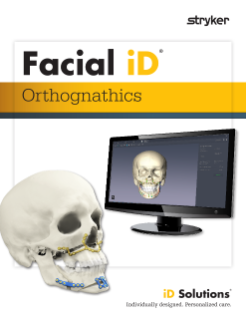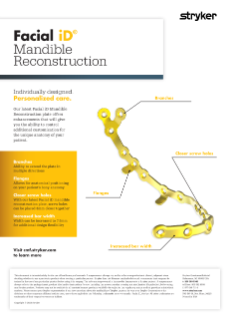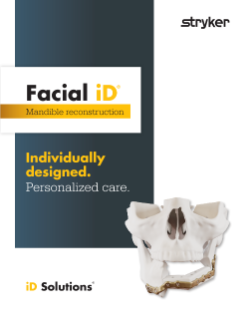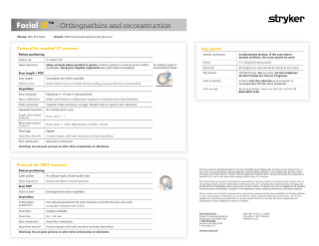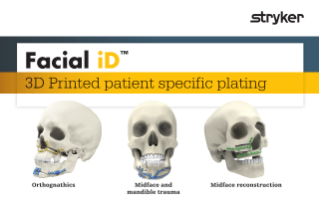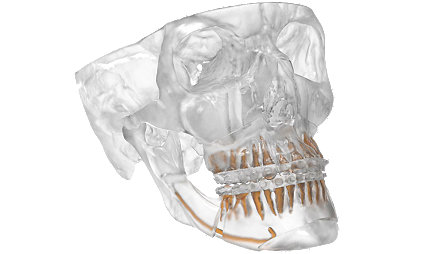Facial iD

Overview
Whether you are looking for midface or mandibular reconstructive solutions, patient-specific orthognathic plates or an implant to address aesthetic needs, our iD Solutions Facial iD portfolio will provide personalized results for your patient. Implants are individually designed with your patient’s CT data while you drive the artistry of the implant during a digital session with our design engineer. Implants are available in a variety of materials depending on anatomical location, including MEDPOR, PEEK and titanium. Provide your patients with an implant designed to fit their anatomy and enhanced aesthetic results.

Orbital reconstruction
We offer a variety of patient-specific options to support your patient’s orbital reconstruction, from PEEK and MEDPOR, to our new titanium orbital reconstruction implants. Plan your patient's orbital reconstruction with confidence. Choose ideal thickness, screw hole placement, and a variety of other features that have been added with our new titanium Facial iD Orbital implants.

Aesthetics
Our MEDPOR patient-specific implants allow you to create the ideal implant design for your patient’s midface or mandible aesthetic needs. During an online interaction with our engineers, you’ll be able to determine the height, width, projection and overall shape of the implant.

Patient-specific titanium plates are manufactured to the planned patient outcome, eliminating the time needed for intraoperative adaptation. Plot the location of every screw hole, select the profile height and bar width, and create a reconstruction plate to meet your patients’ needs.
We collaborate with 3D Systems to offer VSP® solutions to further enhance your patient outcomes with anatomic models and surgical guides.

Midface reconstruction
We have many options to address midface reconstruction, ranging from our newly introduced patient-specific titanium plates to our long-standing MEDPOR and PEEK products.
Our customized reconstruction plates are designed to meet the individual needs of you and your patients. These customized plates are manufactured to the planned patient outcome determined through virtual surgical planning, eliminating the time needed for intraoperative adaptation. This patient-specific approach comes from our partnership with 3D Systems.
We also offer MEDPOR and PEEK materials for midface reconstruction. Each has a well-established history of surgical use and offers you the flexibility to address your patients’ specific needs. You can provide detailed inputs during an online design session with our engineers and map out the exact placement, projection, and other aspects of the implant to match the needs of your patient.

Midface and mandible trauma
Trauma can mean a complete loss of anatomical references and a need for fast analyses. With 3D Systems’ VSP, you can visualize preoperative and repositioned postoperative anatomy, then utilize those VSP decisions to design patient-specific plates to fit your intended surgical plan. Plate design session features include real-time visualization of screw hole placements, bar width and plate thickness.

We can help you take orthognathic surgery to the next level of accuracy and precision, with patient-specific 3D printed plates. Determine osteotomy simulations and bony movement during the VSP session, then design customized plates to provide an optimal fitting plate for your patient. During the plate design session, you can select a range of features including profile height, length of plate and screw hole placement. Make adjustments in real-time and view your final implant design during the session.

Confident plate design
Embrace the next level of patient-specific planning with our patented software that illustrates bone thickness via heat maps. This feature can be utilized during planning sessions to help you identify areas of quality bone for planning the 3D printed plate design and screw hole fixation points. This can provide additional value in orthognathic and midface reconstruction or trauma cases.
Bone thickness measurements are included in all design proposals for customized cases for mandible reconstruction, orthognathic, midface reconstruction and midface or mandible trauma. This measurement feature provides bone depth guidance intraoperatively, to equip you to effortlessly choose the appropriate screw for each hole and fixate the plate in a secure location.
Resources
Clinical evidence
Abstract
The purpose of this paper was to analyze the biomechanical performance of customized mandibular reconstruction plates with optimized strength. The best locations for increasing bar widths were determined with a sensitivity analysis. Standard and customized plates were mounted on mandible models and mechanically tested. Maximum stress in the plate could be reduced from 573 to 393 MPa (−31%) by increasing bar widths. The median fatigue limit was significantly greater (p < 0.001) for customized plates (650 ± 27 N) than for standard plates (475 ± 27 N). Increasing bar widths at case-specific locations was an effective strategy for increasing plate fatigue performance.
Abstract
BACKGROUND
Virtual surgical planning (VSP) has contributed to a number of technical innovations in mandible reconstruction. We report on these innovations and the overall evolution of mandible reconstruction using free fibula flaps at our institution.
METHODS
We performed a retrospective chart review of all patients who underwent virtually planned free fibula flap reconstruction of the mandible. Comparisons were made between cohorts based on distinct eras related to the virtual planning approach.
RESULTS
Seventy-six patients underwent a total of 78 VSP-assisted mandible reconstructions with free fibula flaps. Significant differences were noted among the groups with regard to mean number of segments, percentage of flaps that had at least 3 segments, percentage of flaps that had double-barrel components, and innovations per flap.
CONCLUSION
VSP-assisted mandible reconstruction has contributed to more complex surgeries at our institution. The technology ensures functional restoration, permitting an optimized aesthetic reconstruction that has not increased operative times or complications. © 2016 Wiley Periodicals, Inc. Head Neck 38: E2066-E2073, 2016.
Abstract
INTRODUCTION
Patient-specific implants (PSIs) are accurate, efficient alternatives to traditional plate fixation. They are well-suited for use in procedures that require the utmost accuracy, stability, and efficiency. Although PSIs have demonstrated such qualities in craniomaxillofacial reconstruction, they have so far found limited utilization elsewhere.
CASE PRESENTATION
We explored the departmental protocol for Lefort 1 PSI orthognathic surgery at a high-volume, tertiary referral center. Three cases were selected that matched predetermined criteria, which included treatment by the same surgical team, concurrent Lefort 1 osteotomy and bilateral sagittal split osteotomy, Angle’s type 3 malocclusion, lack of interdental osteotomies, and American Society of Anesthesiologists classification 2 or less without metabolic or osseous diseases. The operative outcomes from these patients were then compared to similar cases also meeting the same criteria and conducted within the same time period.
CONCLUSION
The use of PSI in Lefort 1 osteotomy is associated with anatomically sound designs that could contribute to postoperative stability of the jaws. They also have not shown increased rates of complications such as infection, dehiscence, or relapse at 6 weeks postoperatively but may in fact decrease the operative duration. These findings are consistent with the results gleaned from literature on the use of PSI in craniomaxillofacial reconstruction.
Related products
Facial iD - Mandible Reconstruction
Rigid internal fixation for primary and secondary mandible reconstruction.
Learn moreUniversal Select
Universal Select is the latest in a generation of Craniomaxillofacial fixation systems, featuring a wide selection of high quality implants for bone fixation of Craniomaxillofacial fractures, orthognathic and reconstructive surgery.
Learn moreVSP® Orthognathics
Allows for accurate planning and precise clinical transfer via CAD/CAM splint technology.
Learn moreRequest information
CMF-FID-SYK-1800518

